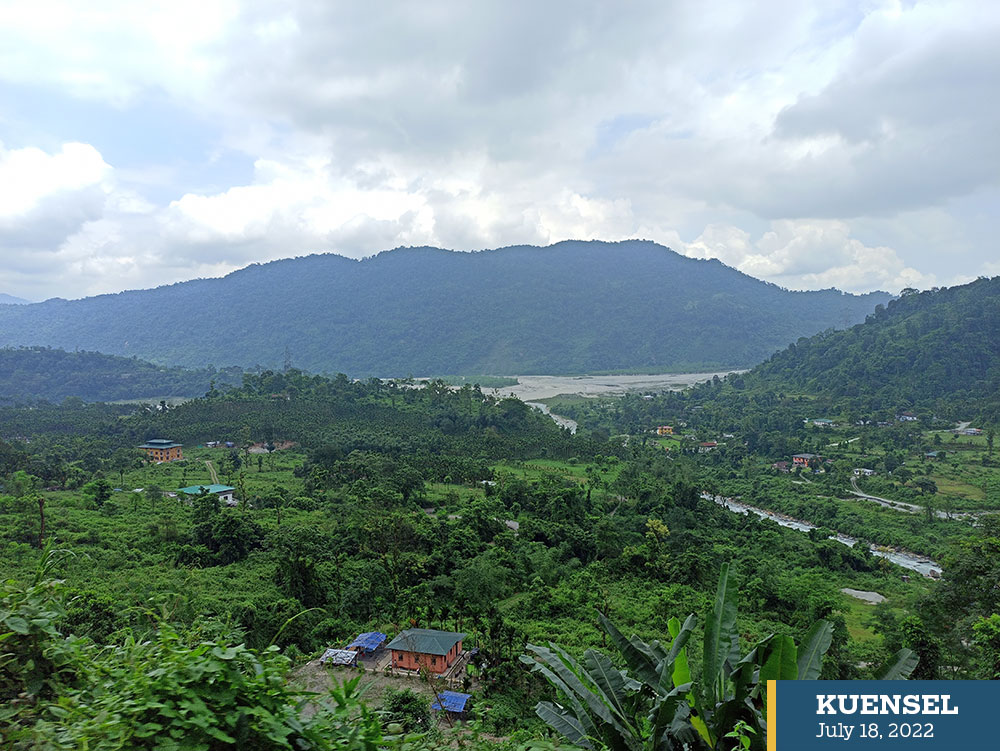Rajesh Rai | Samtse
It all began in 2005 when the construction of Phuentsholing-Samtse highway began. The highway passed through two Lhop (Doya) villages, Namgyel Tapa and Ngawang Dramtoe, among many villages. People from outside Samtse dzongkhags gradually began to buy land in the area.
In 2007, the Lhops received land kidu. They received between three and eight acres. In 2009, the construction of the 175-metre Amochhu bridge also started.
Along with these two projects, talks about a 540MW Amochhu hydroelectric project (AHP), although shelved now, made the land business even more lucrative.
Initially, Namgyel Tapa, due to its proximity to the highway and the gewog office, saw most of the land buyers. But today, even lhops of Ngawang Dramtoe, which is located at a slightly higher elevation, farther from the highway and the gewog office, are seeing an increasing number of land transactions, according to sources.
Despite land transactions not being allowed for 10 years because the land was granted as kidu, lhops kept on selling their lands.
In 2021 alone, 70 lhops from these two villages sold plots of their land. Between 2019 and 2020, about 63 lhops sold numerous plots.
Today, there are only a handful of Lhops in Namgyel Tapa who take pride in not selling their land despite the strong economic and social pressures.
One of them is a 64-year-old Lobzang Doya. “I have to think not only about my children but also about my grandchildren.”
“Ever since I set my hands on the lagthram in 2007, more than 1,000 people have come to my place asking to buy my land. In fact, I was the first person buyers were interested in buying land from.”
Lobzang Doya said that officials who distributed the lagthrams back in 2007 had advised recipients not to sell them. Taking this advice seriously comes as a blessing for Lobzang as he has over 6,000 areca nut trees, which is his primary source of livelihood today.
A few others did not sell their lands in Namgyel Tapa. A total of 84 lhop households received land kidu in Namgyel Tapa.
“This land is the only wealth I have,” 51-year-old Pelzang Doya said. “We are not educated people and land is our life support. I thought of selling the land many times but decided against it.”
Pelzang Doya owns the biggest pineapple farm in Namgyel Tapa today. He also has over 5,000 areca nut trees.
Meanwhile, the price has touched Nu 180,000 per decimal in Namgyel Tapa depending on the location. The average rate is Nu 130,000 to Nu 140,000 per decimal. Doyas inititally sold a decimal at Nu 1,000. In 2017, the price of land near Tading gewog office was between Nu 45,000 and Nu 50,000 per decimal.
“Some of them were sold to multiple people,” a Tading resident said.
One Doya in Namgyel Tapa sold plots to 18 people. Villagers said he doesn’t own much land today. In some cases, doyas sold the same plot to multiple buyers resulting in several court cases. Although Kuensel couldn’t confirm, sources said a few buyers in this case withdrew, while others topped up the price.
A buyer, a driver by profession, said there is a difference between him and other buyers.
“I have to be honest. I bought land here to settle down and I have constructed a house, and am happily settled,” he said.
However, he said that there were people who buy from lhops to sell to others at a higher price.
The driver said that lhops are still selling their land. “Those who sell are mostly into alcohol and don’t save much.”
“If lhops are selling more land these days, it is because of the high rate they get,” a resident said. “But they are not thinking about the future. They are not educated. And on top of that, they have seen the modern ways of life and get tempted to sell off their lands.”
Many lhops sold plots in the hope to construct houses. But many wasted the money and had to sell repeatedly. Alcohol is a major issue in both Ngawang Dramtoe and Namgyel Tapa. A high rate of school dropout has also been recorded in the area in the past.
Lhops are also not much into commercial farming. It is only in the last few years they are looking beyond millet and corn, residents said.
Meanwhile, a farm road from a six-km point towards Samtse from Amochhu bridge leads to Ngawang Dramtoe. It is about 10km away from Amochhu bridge. Land rate here ranges from Nu 6,000 to Nu 10,000. These days, villagers say there are more buyers flocking the area.
Over 104 lhop households in Ngawang Dramtoe received land kidu in 2007. Between 2019 and 2021, about 65 land transactions of plots have been completed. It is not far from Namgyel Tapa’s 66 transactions during the same period.
Tando Doya, 42, sold 1.3 acres of land two years ago. Now he is left with 3.5 acres.
“I sold because I needed money to build a house,” he said, adding that he constructed a house. Tando has three children. He will not sell his land anymore, he added.
It is not only the road and bridge that have increased land value. It is also the development activities in Phuentsholing that have diverted more investors to Namgyel Tapa and Ngawang Dramtoe. Amochu bridge is only eight kms away from Phuentsholing and a four lane road is currently under construction between Phuentsholing and the bridge.
The Phuentsholing Township Development Project (PTDP) is another major project. As Phuentsholing doesn’t have much area to expand and with high land prices in the area, buying land in Tading has become affordable and lucrative.
Now natives from other villages of Tading gewog are also selling their land today.


